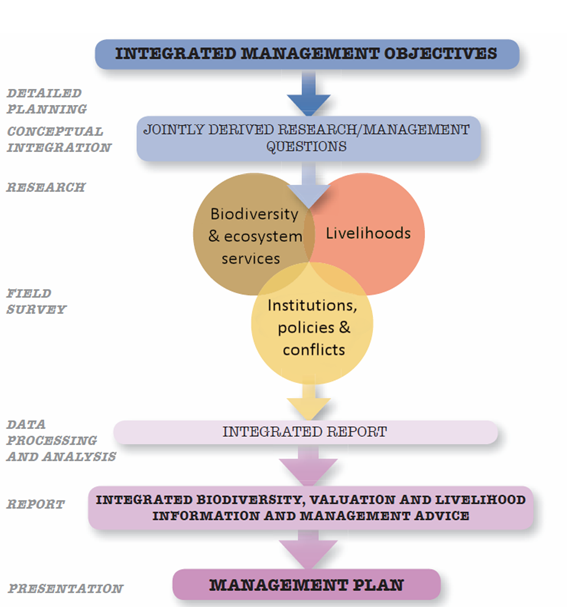“To be effective, equitable and sustainable in practice, wetland management responses must be informed by an understanding of all elements, including their mutual causality and interconnectivity (Springate-Baginsky et al. 2009).”
An “integrated approach” is fundamental to this toolkit, and means that for all the disciplines that need to be considered for wetland resource conservation and sustainable use, such as biodiversity, livelihoods (including gender and age inclusivity), ecosystem services, sustainable energy provision, economics and policy are considered together from the start when developing wetland management plans.
An integrated approach also:
- Supports efficient research and planning. An integrated approach reduces the research and field visits (and respondent fatigue) as rather than having separate teams assessing only one element, integrated teams and field visits can be undertaken.
- Reduces contradictory actions. As all elements are considered when developing management actions, actions that support one aspect (e.g. biodiversity) but harm another (e.g. livelihoods) are avoided.
- Encourages a multidisciplinary approach. Often with the development of wetland management plans one element is comprehensively considered while only assumptions are made regarding the others.
The tools provided in this section of the toolkit are mostly taken from the IUCN Integrated Wetland
Assessment Toolkit (IWAT - funded by UK Darwin Initiative), and provide guidance on how to
incorporate these different elements together from defining management issues and planning the
wetland assessments through to the implementation and monitoring of actions.
It is recommended that the IWAT relevant chapters are read so that the integrated approach is fully
understood and that the assessment planning matrix is used to plan any assessment work (2.1 of the WRAP toolkit). It is also worth highlighting that it is strongly recommended that
experts from the relevant disciplines (biodiversity, policy, livelihoods, economics, etc.) are identified
and incorporated into the planning of work as soon as possible.
Many of the tools throughout this toolkit are designed to support an ‘integrated’ approach but are
not listed in this section, please see the Assessment, Action Planning and Implementation sections for all the tools.
Therefore the tools provided in this section of the toolkit show how to incorporate these different elements together from defining management issues and planning the wetland assessments through to the implementation and monitoring of actions.

An integrated approach to informing wetland management (adapted from Springate-Baginsky et al. 2009)
Springate-Baginski, O., Allen, D. and Darwall, W.R.T. (eds.) 2009. An Integrated Wetland Assessment Toolkit: A guide to good practice. Gland, Switzerland: IUCN and Cambridge, UK: IUCN Species Programme. xv+144p.
| Description | |
| Integrated Wetland Assessment Toolkit (IWAT) – The Whole Report (pdf) | This is the IUCN Integrated Wetland Assessment Toolkit (IWAT) that was previously developed under a Darwin Initiative grant. This report details how to undertake an integrated (biodiversity, livelihoods and economic) assessment of a wetland. It is referred to many times within the HighARCS WRAP toolkit as it was used to guide integration within the assessment phase (see 2.1) of the HighARCS project. |
| IWAT – Chapter 1. Conceptual Framework for Integrated Assessments (pdf) | This chapter of the IUCN IWAT introduces the integrated approach to wetland assessment, and provides a conceptual and methodological framework for assessing wetlands in a fully integrated manner. |
| Assessment Planning Matrix (doc) | This matrix is a critical part of the assessment integration process. Completing the matrix will ensure that all relevant information is collected through the minimum survey efforts. Thus, avoiding multiple time-consuming and expensive surveys being collected at the same site when a well planned integrated assessment could have achieved the same result through a single visit. |
